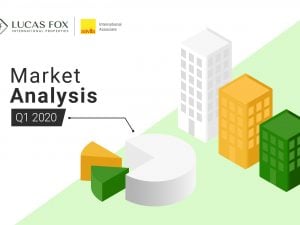Lucas Fox Spanish Real Estate Market Analysis 2019: Spain
A summary of the Spanish property market during 2019 looking at both official and Lucas Fox figures.

Economy, Politics and Tourism
After two general elections in nine months, Spain now has its first ever coalition Government, made up of the Socialist Party (PSOE), headed up by Pedro Sánchez, and Unidas Podemos with its leader Pablo Iglesias. The new coalition will hopefully bring some level of stability after a fairly turbulent year politically and will be addressing political, territorial and social dimensions, which could be challenging but could see some positive outcomes.
Spain’s economy is expected to show growth of 2.1% during 2019 and is forecast to expand by 1.6% in 2020, according to the International Monetary Fund (IMF). This compares with 1.3% for the EU, 1.1% for Germany, 1.3% for France, 0.5% for Italy, 1.4% for the UK and 2% for the USA. Unemployment was at 14.1% in November 2019 (Eurostat) and latest government data shows that the number of employed workers rose by 384,373 (an annual increase of 2.02%) in December 2019.
More than three and a half years after the referendum, the UK has finally left the EU but they still have to decide on a trade deal, among a myriad of other issues. The interim agreement period ends on 31 December 2020, by which time Spanish citizens in the UK and UK citizens in Spain should know where they stand. Spain has always reiterated that it will mirror any new regulations offered by the UK, which are, as yet, unknown. Since the overwhelming UK election victory by the Conservative party in December 2019, the Pound has strengthened against the Euro (1 Pound is currently around 1.18 Euros), which should help motivate British buyers during 2020.
Interest rates continue to be extremely low and therefore make borrowing very attractive. Via some lenders fixed rate mortgages start at 1.55% and variable rates at 1.15% below Euribor.
Spain is on track for a record year of tourist arrivals for the seventh year in succession. Data from November 2019 shows that the number of foreign tourists was up by 2.8% year-on-year to 4.7 million. The main increases were registered in visitors from France (up by 21%), the Netherlands (up by 11%) and Ireland (also up by 11%), according to Spain’s National Institute of Statistics (INE).
Property Market, Spain
Lucas Fox Sales
Lucas Fox had another positive year in 2019 with both the volume and value of its sales increasing significantly. The number of property transactions across the group (currently 24 offices) increased by 48% and the value of sales by 57%, when compared to 2018. 32% of the total sales were for new homes. The average property price also rose, from €869,417 to €923,256, an increase of 6%.
The areas that registered the most significant increases were Barcelona, where sales rose by 78%, and the Catalan coastal town of Sitges, where there were nearly two and half times more sales in 2019 than in 2018. New offices opened in Girona, Pozuelo, Platja d’Aro and Sant Cugat del Vallès during 2019, adding to the seven new offices in 2018 (Alicante, Andorra, Málaga, Menorca, Tarragona, Vigo and Vilanova i la Geltrú,) where total sales more than tripled year-on-year.
Lucas Fox Prime Sales
Sales of homes valued over €900,000 increased by 30% across the group, with an average price of just over €2 million, an increase of 21% when compared to the average prime property price sold in 2018. The areas that registered the greatest increases in prime sales were Barcelona (50% increase), Madrid (30% increase) and Sitges (33% increase).
Lucas Fox New Developments Sales
The number of New Development sales in 2019 more than tripled compared to the number of sales in 2018, largely due to the high number of sales of new homes completed in Barcelona in 2019. These were mainly in the districts of Eixample and Sant Martí (which incorporates the area of Diagonal Mar). The average price of a new home sold by Lucas Fox in 2019 was €936,346, down by 8% when compared to the average price of a new home sold in 2018.
Lucas Fox Buyer Profile
Looking at the buyer profile across the group, 58% of buyers came from outside Spain, down from 66% in 2018, with 42% coming from Spain. The motivation continues to be split fairly evenly between purchasing as a primary residence (33%), a second home (30%) and as an investment property (30%) with 6% buying to obtain the residency Golden Visa.

With regards to prime buyers (those purchasing property over €900,000) 60% of buyers come from outside Spain. International buyers account for a slightly larger proportion of buyers when looking at sales of new homes (67%).
Buyers of prime properties are largely purchasing as either a primary residence (37%) or a second home (36%) with 22% purchasing for investment reasons. The highest proportion of buyers of new homes is accounted for by those purchasing as an investment (38%) with the remainder of buyers mainly being split between those buying as a second home (27%), as a primary residence (16%) and to obtain the Golden Visa (15%).


Sales Prices, Spain
Average sales prices across Spain increased by 4.6% year-on-year, when comparing prices from December 2018 to December 2019, according to the property portal Idealista. Prices have grown by almost 13% since December 2014, around the time when they had bottomed out across the country but are still just under 13% below those in December 2007 when prices were at their peak, suggesting there is still some margin for growth. The provinces that registered some of the most significant price rises were Málaga Province (8.5%), the Balearic Islands (6.6%) and Girona Province (5.2%). Prices in Valencia Province increased by 3.5%, in the Community of Madrid by 3.3% and in Barcelona Province by 3.2%. Prices in Madrid City saw an increase of 1.3% (€3,732 per square metre) and in Valencia City an increase of 3.1% (€1,779 per square metre). However, after 5 years of price rises, property prices in the city of Barcelona are stablising. In 2019 they showed a drop of 2.5%, with prices averaging at €4,115 per square metre in December 2019.
Both Madrid City and Barcelona City have now surpassed the prices registered in December 2007 – by 6.8% and 1.1% respectively. Valencia City prices are still 24.6% below what they were in December 2007.
Comparing prices in Spain’s three major cities in December 2019 to prices in December 2014, around the time of the property turnaround, Madrid prices are up by 38.6%, Barcelona by 34.4% and Valencia by 30.2%.



Sales Transactions, Spain
Government statistics show that the number of sales in the first nine months of 2019 decreased by 4.1% compared to the same period in 2018, bucking the trend of previous years. This was the pattern throughout almost all regions and cities in Spain, largely due to the political instability earlier in the year. Four of the provinces that saw the greatest decreases in sales were the Balearic Islands (14% decrease), Málaga Province (11.5% decrease), the Community of Madrid (9.4% decrease) and Valencia Province (7.8% decrease). The number of sales transactions in Spain in the first nine months of 2019 is just over 62% higher than it was in the same period in 2014 but it is still just over 36% below what is was in the same period in 2007, around the peak. The compound annual growth rate (CAGR) of transaction numbers across Spain in the first nine months of 2019 since the same period 2014 is just over 10%.


The number of sales transactions in Spain’s key cities in the first nine months of 2019 followed the same pattern as in the provinces, seeing annual drops of 13.9% in Valencia and 10.7 % in Madrid. The decrease was much less pronounced in Barcelona where sales fell only by just over 1% when compared to the same period in 2018. Sales of new homes, however, registered an increase across the country as a whole, of 1.2%. One of the biggest increases was in Valencia where the sales of new homes in the first nine months of 2019 almost tripled compared to the same period in 2018, increasing from 184 to 534. In Madrid new homes sales rose by 5.9% but they decreased by 10.3% in Barcelona.

Foreign Buyers, Spain
By the third quarter of 2019 foreign buyers represented almost 12.6% of all buyers of Spanish property according to the Spanish Land Registry. This compares to just 4.2% in 2009. Regions that had the highest proportion of foreign buyers included Málaga Province (which incorporates the Costa del Sol) where nearly 29% of buyers were non-nationals, the Balearic Islands where foreigners accounted for 28% of sales and Girona Province (which includes the Costa Brava) where foreign buyers represented almost 28% of all sales. The region with the highest proportion of foreign buyers has consistently been Alicante Province (which includes the Costa Blanca) where they accounted for nearly 41% of all sales in the third quarter of 2019. Across Spain, most foreign buyers in the third quarter of 2019 came from the United Kingdom (14.3% of foreign buyers) followed by France (8.4%) and Germany (6.6%).

Note the following figures are provisional:
- INE (Tourism) (from January 2019)
- Ministry of Development, Spain (from Q3 2019)
View Lucas Fox Spanish Real Estate Market Analysis Q1-Q3 2019: Barcelona
View Lucas Fox Spanish Real Estate Market Analysis Q1-Q3 2019: Madrid
View Lucas Fox Spanish Real Estate Market Analysis Q1-Q3 2019: Costa Blanca & Valencia
View Lucas Fox Spanish Real Estate Market Analysis Q1-Q3 2019: Costa Brava & Girona
View Lucas Fox Spanish Real Estate Market Analysis Q1-Q3 2019: Barcelona South Coast
View Lucas Fox Spanish Real Estate Market Analysis Q1-Q3 2019: Tarragona
View Lucas Fox Spanish Real Estate Market Analysis Q1-Q3 2019: Costa del Sol
View Lucas Fox Spanish Real Estate Market Analysis Q1-Q3 2019: Galicia
View Lucas Fox Spanish Real Estate Market Analysis Q1-Q3 2019: Ibiza & Menorca






